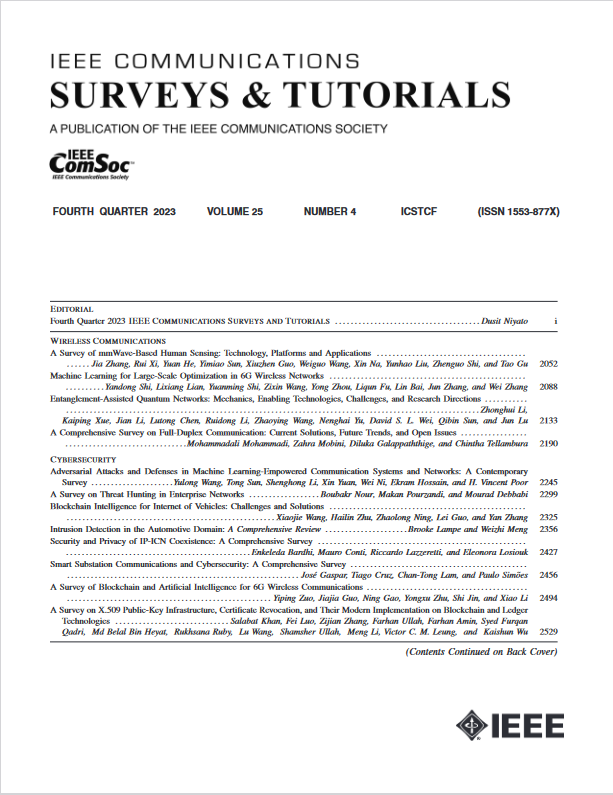Game Theory and Reinforcement Learning for Anti-Jamming Defense in Wireless Communications: Current Research, Challenges, and Solutions
IF 34.4
1区 计算机科学
Q1 COMPUTER SCIENCE, INFORMATION SYSTEMS
引用次数: 0
Abstract
Due to the inherently open and shared nature of the wireless channels, wireless communication networks are vulnerable to jamming attacks, and effective anti-jamming measures are of utmost importance to realize reliable communications. Game theory and reinforcement learning (RL) are powerful mathematical tools in anti-jamming field. This article investigates the anti-jamming problem from the perspective of game theory and RL. First, different anti-jamming domains and anti-jamming strategies are discussed, and technological challenges are globally analyzed from different perspectives. Second, an in-depth systematic and comprehensive survey of each kind of anti-jamming solutions (i.e., game theory and RL) is presented. To be specific, some game models are discussed for game theory based solutions, including Bayesian anti-jamming game, Stackelberg anti-jamming game, stochastic anti-jamming game, zero-sum anti-jamming game, graphical/hypergraphical anti-jamming game, etc. For RL-based anti-jamming solutions, different kinds of RL are given, including Q-learning, multi-armed bandit, deep RL and transfer RL. Third, the strengths and limitations are analyzed for each type of anti-jamming solutions. Finally, we discuss the deep integration of the game theory and RL in solving anti-jamming problems, and a few future research directions are illustrated.博弈论和强化学习用于无线通信中的抗干扰防御:当前研究、挑战和解决方案
由于无线信道固有的开放性和共享性,无线通信网络容易受到干扰攻击,有效的抗干扰措施对实现可靠通信至关重要。博弈论和强化学习(RL)是抗干扰领域强有力的数学工具。本文从博弈论和强化学习的角度研究了系统的抗干扰问题。首先,讨论了不同的抗干扰领域和抗干扰策略,并从不同角度分析了全球范围内的技术挑战。其次,对各种抗干扰解决方案(即博弈论和RL)进行了深入系统的全面调查。具体来说,讨论了基于博弈论解决方案的一些博弈模型,包括贝叶斯抗干扰对策、Stackelberg抗干扰对策、随机抗干扰对策、零和抗干扰对策、图形/超图形抗干扰对策等。针对基于强化学习的抗干扰方案,给出了不同类型的强化学习,包括q学习、多臂强盗、深度强化学习和转移强化学习。第三,分析了各种抗干扰方案的优势和局限性。最后,我们讨论了博弈论与强化学习在解决抗干扰问题中的深度融合,并指出了未来的研究方向。
本文章由计算机程序翻译,如有差异,请以英文原文为准。
求助全文
约1分钟内获得全文
求助全文
来源期刊

IEEE Communications Surveys and Tutorials
COMPUTER SCIENCE, INFORMATION SYSTEMS-TELECOMMUNICATIONS
CiteScore
80.20
自引率
2.50%
发文量
84
审稿时长
6 months
期刊介绍:
IEEE Communications Surveys & Tutorials is an online journal published by the IEEE Communications Society for tutorials and surveys covering all aspects of the communications field. Telecommunications technology is progressing at a rapid pace, and the IEEE Communications Society is committed to providing researchers and other professionals the information and tools to stay abreast. IEEE Communications Surveys and Tutorials focuses on integrating and adding understanding to the existing literature on communications, putting results in context. Whether searching for in-depth information about a familiar area or an introduction into a new area, IEEE Communications Surveys & Tutorials aims to be the premier source of peer-reviewed, comprehensive tutorials and surveys, and pointers to further sources. IEEE Communications Surveys & Tutorials publishes only articles exclusively written for IEEE Communications Surveys & Tutorials and go through a rigorous review process before their publication in the quarterly issues.
A tutorial article in the IEEE Communications Surveys & Tutorials should be designed to help the reader to become familiar with and learn something specific about a chosen topic. In contrast, the term survey, as applied here, is defined to mean a survey of the literature. A survey article in IEEE Communications Surveys & Tutorials should provide a comprehensive review of developments in a selected area, covering its development from its inception to its current state and beyond, and illustrating its development through liberal citations from the literature. Both tutorials and surveys should be tutorial in nature and should be written in a style comprehensible to readers outside the specialty of the article.
 求助内容:
求助内容: 应助结果提醒方式:
应助结果提醒方式:


